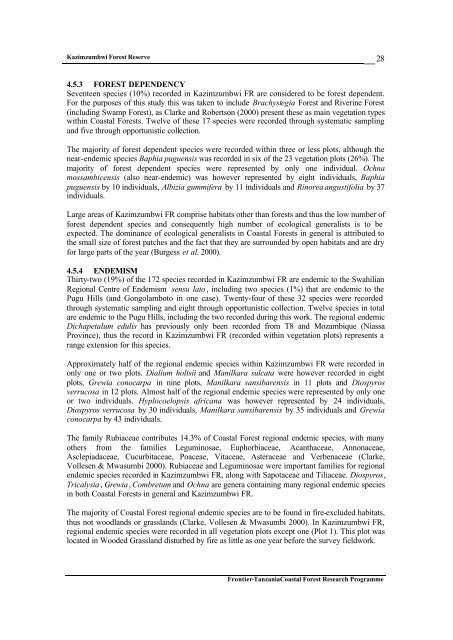Frontier Tanzania Environmental Research REPORT 110 ...
Frontier Tanzania Environmental Research REPORT 110 ...
Frontier Tanzania Environmental Research REPORT 110 ...
You also want an ePaper? Increase the reach of your titles
YUMPU automatically turns print PDFs into web optimized ePapers that Google loves.
Kazimzumbwi Forest Reserve<br />
28<br />
4.5.3 FOREST DEPENDENCY<br />
Seventeen species (10%) recorded in Kazimzumbwi FR are considered to be forest dependent.<br />
For the purposes of this study this was taken to include Brachystegia Forest and Riverine Forest<br />
(including Swamp Forest), as Clarke and Robertson (2000) present these as main vegetation types<br />
within Coastal Forests. Twelve of these 17 species were recorded through systematic sampling<br />
and five through opportunistic collection.<br />
The majority of forest dependent species were recorded within three or less plots, although the<br />
near-endemic species Baphia puguensis was recorded in six of the 23 vegetation plots (26%). The<br />
majority of forest dependent species were represented by only one individual. Ochna<br />
mossambicensis (also near-endemic) was however represented by eight individuals, Baphia<br />
puguensis by 10 individuals, Albizia gummifera by 11 individuals and Rinorea angustifolia by 37<br />
individuals.<br />
Large areas of Kazimzumbwi FR comprise habitats other than forests and thus the low number of<br />
forest dependent species and consequently high number of ecological generalists is to be<br />
expected. The dominance of ecological generalists in Coastal Forests in general is attributed to<br />
the small size of forest patches and the fact that they are surrounded by open habitats and are dry<br />
for large parts of the year (Burgess et al. 2000).<br />
4.5.4 ENDEMISM<br />
Thirty-two (19%) of the 172 species recorded in Kazimzumbwi FR are endemic to the Swahilian<br />
Regional Centre of Endemism sensu lato , including two species (1%) that are endemic to the<br />
Pugu Hills (and Gongolamboto in one case). Twenty-four of these 32 species were recorded<br />
through systematic sampling and eight through opportunistic collection. Twelve species in total<br />
are endemic to the Pugu Hills, including the two recorded during this work. The regional endemic<br />
Dichapetalum edulis has previously only been recorded from T8 and Mozambique (Niassa<br />
Province), thus the record in Kazimzumbwi FR (recorded within vegetation plots) represents a<br />
range extension for this species.<br />
Approximately half of the regional endemic species within Kazimzumbwi FR were recorded in<br />
only one or two plots. Dialium holtsii and Manilkara sulcata were however recorded in eight<br />
plots, Grewia conocarpa in nine plots, Manilkara sansibarensis in 11 plots and Diospyros<br />
verrucosa in 12 plots. Almost half of the regional endemic species were represented by only one<br />
or two individuals. Hyplocoelopsis africana was however represented by 24 individuals,<br />
Diospyros verrucosa by 30 individuals, Manilkara sansibarensis by 35 individuals and Grewia<br />
conocarpa by 43 individuals.<br />
The family Rubiaceae contributes 14.3% of Coastal Forest regional endemic species, with many<br />
others from the families Leguminosae, Euphorbiaceae, Acanthaceae, Annonaceae,<br />
Asclepiadaceae, Cucurbitaceae, Poaceae, Vitaceae, Asteraceae and Verbenaceae (Clarke,<br />
Vollesen & Mwasumbi 2000). Rubiaceae and Leguminosae were important families for regional<br />
endemic species recorded in Kazimzumbwi FR, along with Sapotaceae and Tiliaceae. Diospyros,<br />
Tricalysia , Grewia, Combretum and Ochna are genera containing many regional endemic species<br />
in both Coastal Forests in general and Kazimzumbwi FR.<br />
The majority of Coastal Forest regional endemic species are to be found in fire-excluded habitats,<br />
thus not woodlands or grasslands (Clarke, Vollesen & Mwasumbi 2000). In Kazimzumbwi FR,<br />
regional endemic species were recorded in all vegetation plots except one (Plot 1). This plot was<br />
located in Wooded Grassland disturbed by fire as little as one year before the survey fieldwork.<br />
<strong>Frontier</strong>-<strong>Tanzania</strong>Coastal Forest <strong>Research</strong> Programme

















